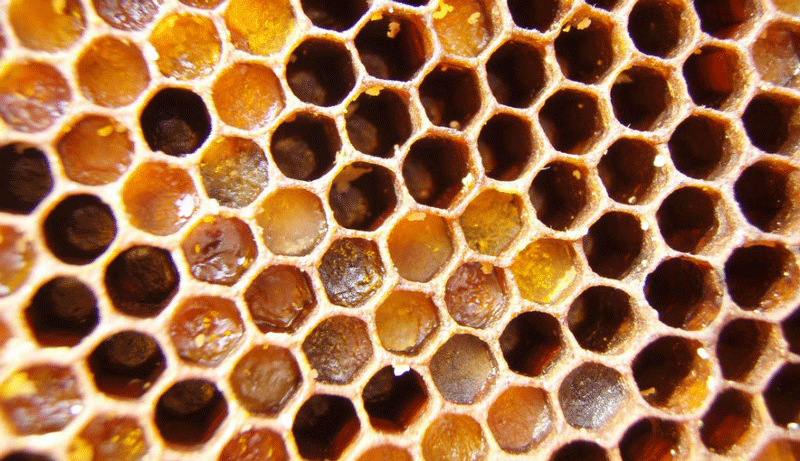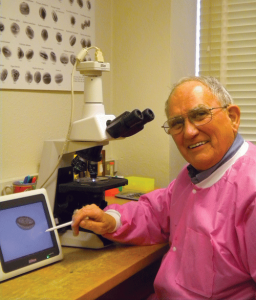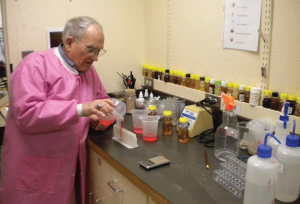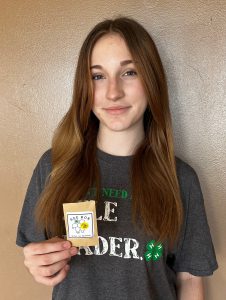By: Vaughn Bryant, Texas A&M
It’s Not As Easy As You Think!
“Hello, Dr. Bryant could I visit your lab this weekend and learn how to identify my honey samples by examining the pollen contents?”
Unfortunately, I get these types of emails and telephone calls fairly regularly. The problem is not my unwillingness to spend time with beekeepers wanting to learn how to examine pollen; the problem is that a weekend visit is totally inadequate for learning this complex type of analysis. I usually respond to these enquires with a positive reply offering to work with them if they wish, but adding that “I have been doing this for over 40 years and I am just now getting good at it!” That replay usually discourages most of the callers, but not all of them. The diehard ones insist on coming anyway and after several days discover that what I told them was true; one cannot learn to do this adequately in a weekend, a month, or even a year. To analyze honey samples using the pollen contents requires a “long learning curve!” This is not to say that it is impossible for a beekeeper to learn how to do this, but most of those who want to do it do not have the needed botanical background, the equipment to do the extraction process, or the pollen reference collections needed to help them identify the potential thousands of pollen types they could find in their samples. Nevertheless, there have been a few successes.
A retired biology teacher and an active member of a beekeeping group decided that he and his fellow beekeepers wanted to develop a guide to the pollen types typically found in honey produced in the Southeastern United States. They were very enthusiastic, very committed, and eager to learn how to complete this task. I worked with this group for over two years helping them learn how to collect and then prepare pollen reference material, how to identify and document the plants they believed were the primary nectar and pollen contributors in their region, how to extract the pollen from their honey samples, and how to photograph the pollen and prepare the pictures in a format that could be developed into an atlas of pollen types for their region. They had access to the equipment they needed and were permitted to use the microscopes and camera equipment in the biology department of a local junior college.
The group began with great resolve. Members collected, photographed, and reported the local abundance and distribution of what they believed were the key nectar and pollen producing plants in their region. They learned to extract the pollen from the flowers, made adequate photographs of the pollen, learned to describe the morphology of those pollen types, and began to develop the pages for an atlas of pollen types. They made great progress the first year but by the second year they were contacting me less and less and by the end of the year they decided their project was just too much work so they abandoned it after collecting information on about 25 different plants. Unfortunately, this example stems from a common problem; interested beekeepers and groups who want to do this often begin with great enthusiasm but soon find the task overwhelming and far too time-consuming, which then leads to an abandonment of their goals.
More recently, an individual in West Virginia, using grant money from the state’s agricultural program has begun the task of identifying the key pollen resources collected by honey bees in his region. He is a beekeeper with extensive botanical experience and has worked with his fellow beekeepers on a system to collect pollen pellets from beehives in a methodical manner during different times of the year. He then sends those samples to our lab where we process the pellets and return the extracted pollen to him to analyze. We have also sent him reference materials, pollen keys, and assisted in the identification of many pollen types to ensure that what he is reporting is an accurate reflection of the true pollen types that were collected. He completed the first year of this project, produced an excellent report of his findings and has now applied for additional grant funding to continue and expand his efforts during the coming year. Of all the previous beekeepers who wanted to learn how to do this or learn how to examine the pollen in honey, this person is the best example of a success story. Thus far he has followed through on his commitment and has been willing to spent the enormous amount of time it has taken to collect the samples, then learn the pollen types, and finally to do the analysis of each collected group of pollen pellets. His first year’s report is excellent and will serve as a valuable resource for local beekeepers. It will also serve as a guide to which plants the bees favor for pollen collection and can be used as a guide to encourage others to plant more of those key plant types for bees to use.
The more I work with beekeepers, producers, and honey importers the more I discover that there is growing interest in learning how to identify the sources of pollen and nectar needed to help honey bees survive and hopefully help to stem the problem of colony collapse. As many scientists have reported, healthy bees seem to be able to weather many of the problems that can cause colony collapse. In spite of this growing awareness and interest, there seems to be few efforts to expand pollen studies or the honey analyses that are needed.
I began examining honey samples in 1975, when asked by the Office of the Inspector General of the USDA to assist them in determining the origin and floral contents of honey they were buying as part of the United States Farm Loan Act of 1916. That law established a “floor price” for many agricultural products, including honey, below which the Federal Government would not allow products to be sold within the United States. This was an attempt to stabilize food costs and provide farmer’s with a guaranteed price for their goods. Thus, beekeepers and honey producers were guaranteed that they could sell their honey for at least the “floor price” set by the USDA. This policy worked effectively and was governed by the Federal Farm Loan Board. The problem arose when the world price for an agricultural product, such as honey, fell below the floor price set by the Farm Loan Board. At that point, beekeepers would have to sell their honey on the world market for a loss unless the beekeeper could “lend” their honey to the Farm Loan Board at the established floor price and then use the money to pay their bills. Later, the beekeeper could request the return of their honey provided the loan was repaid to the Farm Loan Board, including a modest amount of interest. That often occurred when the world price for honey rose above the floor price meaning the retrieved honey could now be sold on the open market for a higher profit.
That system worked effectively for decades until the early 1970s when the world price for honey began to decline and finally reached levels below the U.S. established floor price set by the Farm Loan Board. The result was a flood of requests by U.S. beekeepers to lend their honey to the Farm Loan Board for the agreed floor price rather than being forced to sell their honey on the open market at a loss. By the mid-1970s the amount of honey being stored by the U.S. government as part of loans made by the Farm Loan Board Banks increased by several hundred percent annually, which caused government agents to become suspicious that not all of the honey they were storing met the criteria of being “domestically produced within the U.S.” That is where I came into the picture. I am a palynologist, someone who studies pollen, and pollen in honey is the primary method used to identify the origin of honey and also the floral nectar sources.
There are very few scientists in the U.S. who examine pollen and during the 1970s most of those who did work with pollen were employed by the petroleum industry because pollen trapped in ancient deposits can be used as guides to the presence of plant materials that were later compressed and changed into natural gas and oil deposits. Therefore, the USDA had great difficulty trying to find anyone willing to examine their stored honey since the pollen analysts working in industry had no desire or time to pursue that task. The USDA admitted I was their last hope because others had turned them down. They hoped that because I was one of the few palynologists working in academia on modern, rather than ancient pollen records I might be willing to help them. The authorities explained their problem and asked if I would help them determine if the honey they were purchasing was indeed “domestic” honey rather than illegal foreign honey purchased at cheaper prices and then “relabeled” as being domestic to qualify for the higher floor price set by the loan program. I had never looked at a honey sample but I guessed it would not be difficult since I had recently graduated from The University of Texas with a doctorate in botany and a specialization in the study of pollen. For $50/sample, which was a lot of money in 1975, I agreed to examine 100 honey samples selected by the USDA from their honey storage repositories. Looking back, I now realize that I was totally naïve about the diversity of pollen and nectar sources available for honey bees within the United State. According to recent botanical records, worldwide there are over 352,000 angiosperms (flowering plants) from which honey bees can collect pollen and/or nectar. Of that total about 17,000 species are native to the United States. An estimated additional 3,800+ ornamental flowering plants have been introduced into the U.S., not counting hundreds or maybe thousands of additional species of introduced agricultural plants, and new plant species continue to be introduced into the U.S. annually.
As a graduate student I had examined many types of archaeological, lake, bog, and other types of deposits to extract and analyze the trapped and fossil types of pollen. I suspect that by the time I completed my studies I could recognize several hundred pollen types by sight and could guess the identity of several hundred more. That, I very soon discovered was totally inadequate for looking at any honey sample. In those first 100 honey samples I received there were hundreds of new pollen types I had never seen before; it was pollen collected by honey bees foraging on plants in the many different floristic zones within the United States. That was my first major problem, but not the only one. I quickly realized that I also had to learn the pollen types of plants in other world regions so I could determine if a honey sample was domestic to the U.S. or originated in a foreign region, which would make it illegal for the loan program. After looking at a few of the honey samples I wanted to send them all back to the USDA telling them it was an impossible task, especially for $50/sample. However, my pride prevented me from giving up and the challenge to do something nobody else in the U.S. was willing to do, made me determined to solve my pollen identification problem. I spent the summer of 1975, working harder than I had ever worked as a graduate student learning hundreds of new pollen types from the few published pollen atlases available, from published journal and book reports of honey studies conducted in Europe and other countries, and from collecting flowers and expanding my modern pollen reference database of microscope slides. Today, I estimate that I may have earned about 10 cents an hour for my honey work that first Summer. However, by the end of the Summer of 1975, I had greatly expanded my pollen database and I was able to provide some fairly accurate estimates about which honey samples were produced in the U.S. and which were not. The USDA decided to continue that honey identification program for the next four years until the world market price for honey greatly exceeded the established floor price set by the Farm Loan Board. After that, the USDA lost interest in trying to identify honey and they have never again asked me or anyone else to examine more honey samples. By the early 1980s I had gained a much better knowledge of honey samples and I had greatly expanded my pollen database, but of the 17,000 plus pollen types in the U.S. I still only knew a few hundred by sight and could only guess about the rest, which I tried to track down and identify by searching in published sources or by sending pictures to other palynologists in hopes they might know the unknown pollen type. Unfortunately, since nobody else in the U.S. was working with honey, those other palynologists were rarely much help with the unknown pollen types.
The world of people doing palynology is very limited and thus most of us know who the others are who also work in the field. Because of my close association with U.S. palynologists working in the Petroleum Industry I not only knew what they were doing but I also benefited from many of their research ideas and insights about pollen extraction from various matrix materials, and about pollen production and preservation. After all, industry had all the funding and resources they needed since pollen played a key role in improving their recovery of gas and oil, and thus increased their profits. Twice, I was offered a job doing pollen work for one of the petroleum companies at more than triple the salary I earned in academia; however, I enjoy teaching and doing pollen research, both of which I would have had to give up if I left academia, so I never did. One benefit, however, was that when EXXON and Mobil Oil merged they had two pollen reference collections. I encouraged them to donate one of them to our university, Texas A&M, which they did. Soon after that British Petroleum (BP) and the American Oil Company (AMOCO) merged and they also had two pollen reference collections, one of which I encouraged them to give to us. Thus, over the span of a decade our modern pollen reference collection expanded from about 2,000 taxa to over 20,000 types with a large emphasis and majority of those new pollen reference types coming from plants native to many non-North American regions such as Africa, Central and South America, and many areas of Asia. Those additional reference slides have enabled us to expand our pollen knowledge of many foreign regions and thus equipped us to be able to identify the geographical origins and nectar types of many honey samples imported into the U.S. by honey distributors and honey companies. It has also enabled us to be on the forefront of being able to search for and help identify the original origins of many illegally transshipped honey samples entering the U.S.
What began in 1975 as a favor to help the USDA and as a challenge to force me to expand my basic knowledge of pollen types from around the world has grown to become an almost overwhelming effort and at times a problem. From 1975 until the late 1990s my research focus turned to other types of pollen studies related to paleoenvironmental reconstructions, searching for the origins of agriculture, focusing on the identification of consumed pollen as guides to ancient human nutrition, food selection, and food preparation techniques; and exploring the use of pollen as trace evidence in forensics. After the late 1990s the illegal importation of honey, the beginning of illegal transshipping of honey, consumer concerns about the safety of purchased honey, and the beginning of a realization that there was no legal requirements for truth in labeling the types of commercial honey sold in stores led to a slow increase in requests asking me to begin examining honey samples once again. By the beginning of the twenty-first century requests to our pollen lab to examine honey samples began to increase each year and by 2012, the flow of honey samples was becoming a fairly constant stream. That year I examined around 150 honey samples and each year after that the number of honey samples continued to increase until by 2016, it had reached over 300 samples. As 2017 begins, the flow of honey samples for analysis has already begun and there is no sign that the numbers are going to decrease anytime soon.
All of this discussion leads to two final questions: why do I examine honey and why am I the only one in the United States doing this on a regular basis? Let me answer the first question by saying that I consider the analysis of honey samples to be the greatest research challenge any pollen analyst could ever face. If one can learn to examine and identify the pollen in honey samples it will provide the background that person can use to conduct almost any other type of pollen research and it provides the type of background one needs to use pollen in forensic applications. To do most archaeological pollen analyses, especially in areas of North America, one might never need to know or recognize more than 100-200 pollen types. Using pollen to examine ancient North American deposits in lakes and bogs in order to record and reconstruct vegetation changes through time might require only a slight expansion of the 200 pollen type limit. However, to examine honey samples even from a small region of the United States requires a vast expansion of a person’s basic pollen database of knowledge. In my published study of the analysis of 37 honey samples collected from hives in a few counties in East Texas my co-worker and I found those few samples contained over 431 different pollen species! That small East Texas honey study required us to know and recognize more pollen types than is required to analyze either archaeological or paleoenvironmental pollen studies from deposits anywhere in North America. Now expand that limited study of 37 honey samples collected from one small geographical area to include not only the rest of Texas but also the entire United States with it more than 20,000 potential bee foraging plant types. I suspect you can now begin to appreciate the potential task one faces when trying to analyze honey samples. Add to that the need to know and recognize major pollen taxa from plants native to other regions of the world and the task begins to look enormous; remember, conservative estimates claim that worldwide there are over 352,000 plant species from which bees could collect either pollen or nectar.
Now to address the second question; why am I the only person doing honey analyses in the United States on a regular basis? The first reason is that there is a lack of specialists in the U.S. who have the background training, interest, and willingness to conduct pollen studies of honey. This is a serious problem because there is a need for more palynologists in the U.S. who could analyze honey and who could begin to identify key honey plants and honey types for each of the major regions of the U.S. What causes this problem relates to the academic training in U.S. colleges and universities; none of them teach how to identify pollen in honey or how to analyze honey using pollen technique. Pollen studies are offered in some U.S. universities, but those studies are in departments of geology, geography, anthropology, and occasionally biology, but none are in entomology. Academic centers in other regions of the world offer training in pollen studies of honey because it is considered an important national asset. Those countries also provide employment opportunities for those trained pollen specialists. This relates to the second problem in the U.S.; there is a lack of jobs for those trained to do pollen studies of honey. Because the U.S. has no legal requirements for truth in labeling honey samples, there are no large federal or state testing programs that would ensure that companies complied with truth in labeling requirements. Because the US has no required testing requirements, there is little need for experts who could test honey samples. Yes, there is some need as evidenced by the flood of samples I receive each year for analysis. However, the minimal fees we charge for examining those honey samples would not be sufficient to provide full-time employment for highly-trained individuals. The final part of the answer to this question relates to funding. There is no major funding program at the federal, state, or even university level that would assist or encourage scientists to pursue pollen studies of honey. For the more than four decades I have worked here, my university has provided our pollen lab with free water and electricity, but that is all. Everything else that is needed to do our research, including honey studies, must come from outside funding. For example, we must depend on grant and contract funding earned from doing honey analyses, forensics for law enforcement agencies, archaeological studies, and paleoenvironmental reconstructions using pollen. Currently, our pollen lab charges a very modest fee for honey analyses, which barely covers the costs of chemicals, equipment, and minimal amounts of salary. If we raised our fees I doubt many individual beekeepers could afford to have their honey studied and I suspect even those who import and sell commercial honey might not be willing to continue their verification programs related to the honey they purchase and sell.
So where do we go from here? What is the future for pollen studies of honey and the studies of honey bee pollen pellets? Without federal, state, or local laws requiring truth in labeling we will continue to doubt what is really inside a jar of labeled honey or a packet of pollen pellets sold in stores. We won’t be able to tell whether the honey we buy really is some premium type for which we are willing to pay a high price, or if instead the labeled premium honey might be some common and inexpensive type being passed off as a premium type.
That issue, related to the extensive problem centered on a lack of truth in labeling in the U.S. honey industry and deceptions about types of honey for sale throughout the U.S. will be the focus of my next article. I also plan to discuss related steps that some beekeepers and some states are doing on their own to police the problem, and steps being taken to regain consumer confidence by those who purchase honey for their own consumption.











